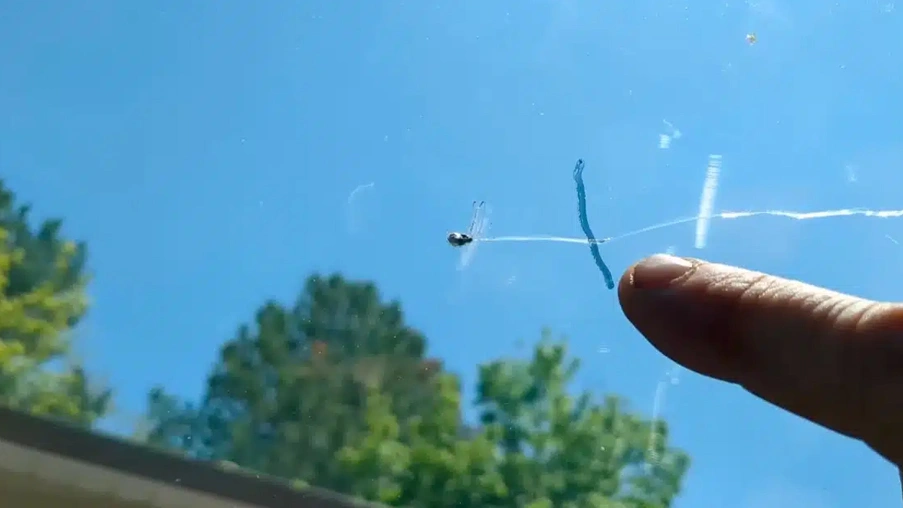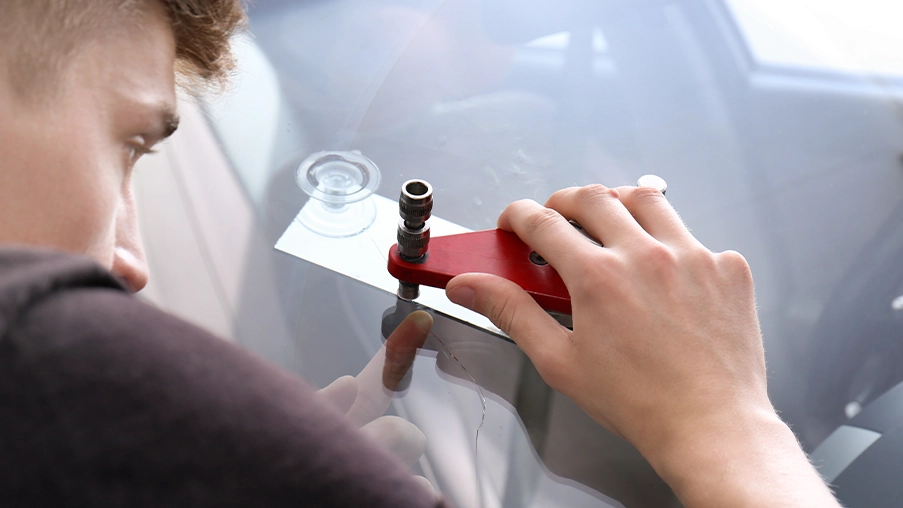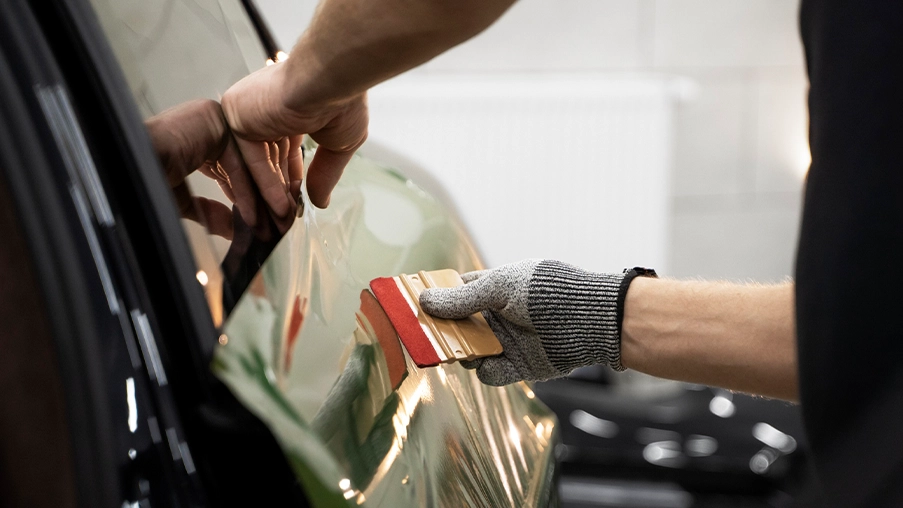Windshield Pit vs. Chip: Key Differences & Repair Guide
February 17, 2025
A damaged windshield can impair visibility and safety, but not all glass flaws are the same. While windshield pits and chips can look similar, they have unique causes, effects, and needs for repairs. Pits form as small bits of debris wear away at the glass surface over time, while chips happen when something strikes the glass with enough force to break off a small piece.
Both can compromise your safety by increasing the likelihood of accidents. Knowing the difference between windshield pit vs. chip helps one decide whether windshield repair is required or a complete replacement. In this blog, we will review their primary reasons and repair techniques.
What Is a Windshield Pit?
A windshield pit is a small indentation on the glass surface caused by sand, dirt, or small stones hitting the windshield while your vehicle is moving at high speeds. Unlike chips or fractures, pits do not penetrate the glass but gradually degrade the outermost layer. Over time, these little surface pitting spots on the windshield can scatter light and cause glare, which can interfere with visibility.
A single pit may not be cause for concern, but if there are several, the structural integrity of the windshield is compromised. Weathering and driving on untreated pits can expand in size.
Windshield pit repairs will level the surface of the glass, smooth it out, and provide an area where the repair can hold its position without loss of clarity, preventing the pit from degrading further. However, if your windshield has extensive pitting, a repair or replacement may be necessary.
What Is a Windshield Chip?
A windshield chip is caused by a direct impact on the glass, such as when a rock or hail strikes it. Unlike a windshield pit, which is a surface-level indent, a chip penetrates deeper into the glass, often forming tiny fractures that can expand over time. Chips of several types, including bullseye, star, and combination, with variable severity and risk.
If left unrepaired, chips can worsen due to temperature changes, or moisture, eventually leading to cracks that compromise the windshield’s integrity. Windshield repair & replacement professionals often use resin injections to fix minor chips, restoring the glass’s strength and visibility. However, full autoglass repair & replacement may be required if the damage spreads.
In vehicles equipped with advanced driver-assistance systems (ADAS), replacing the windshield necessitates ADAS calibration to restore the functioning of lane departure alerts, adaptive cruise control, and other safety features to continue to function properly following repairs.
Windshield Pit Vs Chip: Key Differences
Both windshield pits and chips are common types of glass damage, but they differ in severity, risk, and repair methods. The table below highlights their key distinctions:
| Feature | Windshield Pit | Windshield Chip |
|---|---|---|
| Cause | Wear from dust, sand, and small debris | Impact from rocks, hail, or other solid objects |
| Depth | Surface-level indentation, no deep fractures | Breaks into the glass, sometimes creating fractures |
| Risk of Spreading | Minimal unless multiple pits weaken the glass | High; can expand into long cracks |
| Visibility Impact | Can cause minor glare but usually does not obstruct vision | May distort visibility and worsen over time |
| Repair Method | Windshield pit repair using polishing or resin filling | Resin injection for minor chips; auto glass repair & replacement for larger damage |
| ADAS Calibration Needed? | No, unless part of a full windshield replacement | Yes, if the vehicle is ADAS-equipped |
When to Repair or Replace?
The severity and location of the damage determine whether to opt for windshield pit repair or a full windshield repair & replacement.
Repair is possible when:
- The windshield pit is shallow and does not obstruct vision.
- A chip is smaller than a quarter and has no deep cracks.
- The damage is not near the ADAS calibration sensors or the driver’s line of sight.
Replacement is necessary when:
- A chip has spread into a large crack, affecting structural integrity.
- Multiple surface pit windshield damages weaken the glass.
- The damage is within the ADAS sensor area, requiring a recalibrated windshield.
Autoglass repair & replacement should be done in a timely manner to prevent minor problems from getting worse. Neglecting damaged windshields can increase the risk to safety. Windshield professionals like NuVision Auto Glass can determine the correct method to proceed, whether to repair or completely change the windshield with ADAS calibration.
How to Prevent Windshield Pits and Chips
To reduce windshield pits and chips, do these preventive measures:
- Maintain a safe following distance: Avoid tailgating heavy trucks and construction vehicles that generate debris.
- Drive Caution on Rough Roads: Uneven roads with loose gravel increase the likelihood of minor collisions.
- Park in Sheltered Areas: Parking in garages or shaded areas protects against excessive temperature swings.
- Use a Windshield Cover: This minimizes direct sun exposure, which lowers the incidence of stress fractures.
- Clean Your Windshield Regularly: Dirt and debris can damage the glass and lead to surface pit formation.
- Inspect for Minor Damage: Small pits or chips should be repaired right away using windshield pit repair services.
- Schedule professional repairs: For more serious damage, consider autoglass repair & replacement and ensure appropriate ADAS calibration.
Conclusion
Knowing the difference between a windshield pit and a chip is critical for car safety maintenance. Pits are minor surface defects, whereas chips go deeper if not corrected.
Repairing windshield pits can prevent damage, but most major cracks require windshield repair & replacement. Neglecting minor windshield damage affects visibility and weakens the glass, which can lead to more cracks.
If you see pits or chips, get autoglass repair & replacement as soon as possible. Consider NuVision Auto Glass for expert services like ADAS calibration to restore your windshield’s integrity and safety. Call us today!
FAQs
1. Is a chip or cracked windshield better?
Windshield chips are typically easier to repair than cracks. Chips are little areas of damage that do not compromise the overall structure’s integrity. However, a crack might spread with time.
2. How much should a windshield chip repair cost?
The cost incurred for windshield pit or chip repair is determined by certain factors like the seriousness of the chip, its location, and who the service provider is. Minor chip repairs would cost between $50 and $150 on average, whereas those with extensive damage would need complete windshield replacement.
3. Does insurance cover a cracked windshield?
Most comprehensive insurance policies will pay for windshield repair or replacement without a deductible. Additionally, many such policies contain a zero-deductible provision, especially in states with free windshield replacement laws. Check your coverage to see whether ADAS calibration is provided after a replacement.




